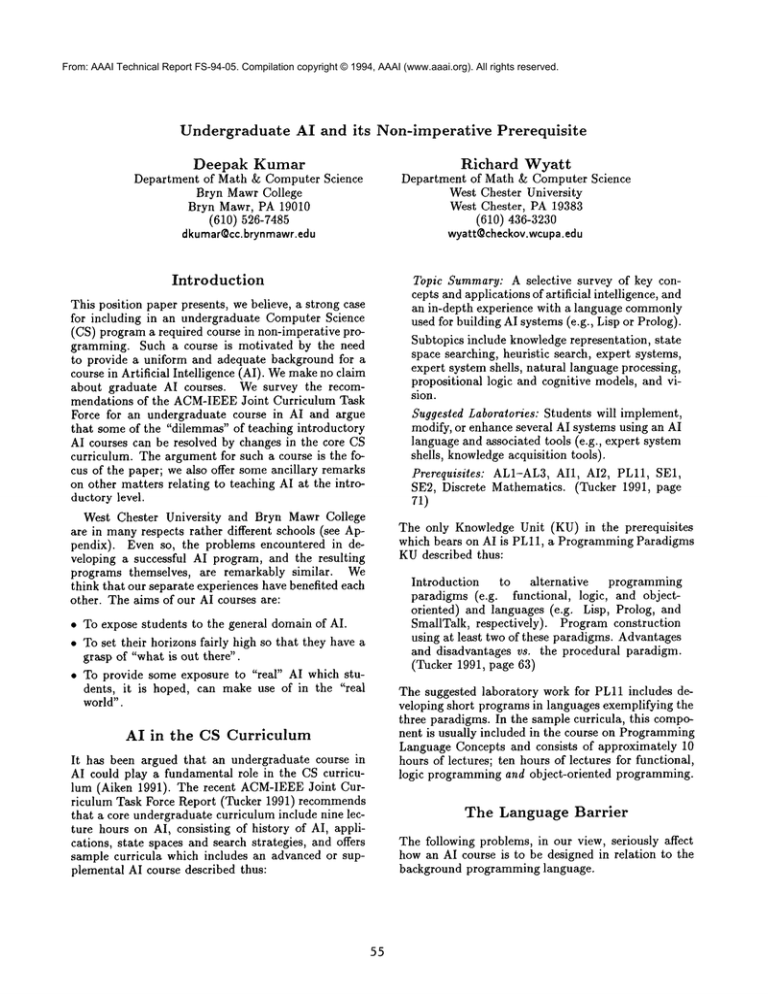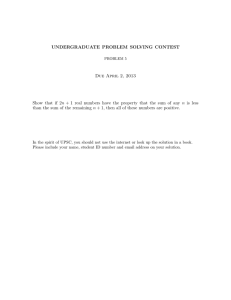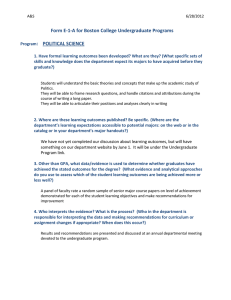
From: AAAI Technical Report FS-94-05. Compilation copyright © 1994, AAAI (www.aaai.org). All rights reserved.
Undergraduate
AI and
its
Non-imperative
Deepak
Kumar
Department of Math & Computer Science
Bryn Mawr College
Bryn Mawr, PA 19010
(610) 526-7485
dkumar@cc.brynmawr.edu
Richard
Wyatt
Department of Math & Computer Science
West Chester University
West Chester, PA 19383
(610) 436-3230
wyatt@checkov.wcupa.edu
Introduction
This position paper presents, we believe, a strong case
for including in an undergraduate Computer Science
(CS) program a required course in non-imperative programming. Such a course is motivated by the need
to provide a uniform and adequate background for a
course in Artificial Intelligence (AI). Wemakeno claim
about graduate AI courses. We survey the recommendations of the ACM-IEEEJoint Curriculum Task
Force for an undergraduate course in AI and argue
that some of the "dilemmas" of teaching introductory
AI courses can be resolved by changes in the core CS
curriculum. The argument for such a course is the focus of the paper; we also offer some ancillary remarks
on other matters relating to teaching AI at the introductory level.
West Chester University and Bryn Mawr College
are in manyrespects rather different schools (see Appendix). Even so, the problems encountered in developing a successful AI program, and the resulting
programs themselves, are remarkably similar. We
think that our separate experiences have benefited each
other. The aims of our AI courses are:
* To expose students to the general domain of AI.
¯ To set their horizons fairly high so that they have a
grasp of "what is out there".
¯ To provide some exposure to "real" AI which students, it is hoped, can make use of in the "real
world".
AI in
the
Prerequisite
CS Curriculum
It has been argued that an undergraduate course in
AI could play a fundamental role in the CS curriculum (Aiken 1991). The recent ACM-IEEEJoint Curriculum Task Force Report (Tucker 1991) recommends
that a core undergraduate curriculum include nine lecture hours on AI, consisting of history of AI, applications, state spaces and search strategies, and offers
sample curricula which includes an advanced or supplemental AI course described thus:
55
Topic Summary: A selective survey of key concepts and applications of artificial intelligence, and
an in-depth experience with a language commonly
used for building AI systems (e.g., Lisp or Prolog).
Subtopics include knowledgerepresentation, state
space searching, heuristic search, expert systems,
expert system shells, natural language processing,
propositional logic and cognitive models, and vision.
Suggested Laboratories: Students will implement,
modify, or enhance several AI systems using an AI
language and associated tools (e.g., expert system
shells, knowledgeacquisition tools).
Prerequisites:
AL1-AL3, AI1, AI2, PLll, SE1,
SE2, Discrete Mathematics. (Tucker 1991, page
71)
The only Knowledge Unit (KU) in the prerequisites
which bears on AI is PLll, a Programming Paradigms
KUdescribed thus:
Introduction
to alternative
programming
paradigms (e.g. functional, logic, and objectoriented) and languages (e.g. Lisp, Prolog, and
SmallTalk, respectively).
Program construction
using at least two of these paradigms. Advantages
and disadvantages vs. the procedural paradigm.
(Tucker 1991, page 63)
The suggested laboratory work for PLll includes developing short programs in languages exemplifying the
three paradigms. In the sample curricula, this component is usually included in the course on Programming
Language Concepts and consists of approximately 10
hours of lectures; ten hours of lectures for functional,
logic programming and object-oriented
programming.
The
Language
Barrier
The following problems, in our view, seriously affect
how an AI course is to be designed in relation to the
background programming language.
1. Someschools ignore the non-imperative languages
altogether and usually end up offering an AI course
which might best be described as pseudo-AI. Other
schools transfer the responsibility of learning Lisp
or Prolog to the AI course itself. This confuses AI
with the meansof implementation. While Lisp and
Prolog (and, for that matter, object-oriented programming)
have their roots in AI, they are no longer
considered "AI Languages". Lisp is an exampleof
a functional programming
language, at least in its
pure form, and Prolog of logic programming.
2. The ACM-IEEE
guidelines, which recommendsten
hoursof lectures, do not suffice to providethe needed
backgroundin alternative programmingparadigms.
For example, in a Lisp based AI course which relied on such a backgroundcourse, the students could
be expected to have had a mere four or five hours
of prior languageinstruction. This is entirely inadequate for all but the most trivial of purposes.
Moreover, devoting time to functional and logicbased languages in a ProgrammingLanguage Concepts course takes time away from the important
task, whichis the focus of such a course, of examining in detail the run-time structure of programming
languages. Most of this examination traditionally
involves imperative (procedural) languages. Rather
than additionally learning the run-time structure of
functional, logic, and object-oriented languages,one
is forced, if one follows the ACM-IEEE
guidelines, to
learn --or merelybe exposedto --just their syntax.
3. In most first courses in AI, somestudents start out
with an elementary knowledgeof Lisp or Prolog.
But manydo not; manyhave never seen a single
non-imperative language. If the course is pitched
to the former, it tends to exclude the latter, but
if pitched to the latter, the former are invariably
"under" taught. Thoughsuch issues arise with all
classes, it is especially acute in AI becauseadequate
instruction in non-imperativelanguagesis still not
mainstream. In fact, many CS programs graduate students without any knowledgeof functional or
logic programming
paradigmsat all.
4. Whena serious backgroundcourse more or less devoted to non-imperativelanguagesis offered, it is
usually an upper-level elective course. Thus, by the
time AI is offered, manystudents whoare otherwise
interested in taking the course discover that they
are unable to do so becausethey have not taken the
prerequisite. Again, though this issue arises with
mostcourses, it is especially acute in AI. Students,
manyof them, have a narrow, even naive, view of
the discipline. They tend to prefer courses such as
imperative programming,networking, and operating
systems, rather than those such as theory of computation, non-imperative programming,and AI. Part
of the reason, wesuspect, is that manystudents focus too muchon the perceived extent to whichtheir
56
courseswill afford immediate
andclear skills of interest to industry, rather than the longer term benefits
of a thorough understanding of the discipline. In
any case, students often will not chooseas an elective a course in non-imperativeprogramming
and, if
AI were to require such a course as a prerequisite,
would thus find themselves, perhaps inadvertently,
excluded from AI.
A Solution
Thoughan undergraduate introduction to AI should
concentrate mainly on the concepts relevant to AI, it
should also provide a considerable exposureto implementation matters. The neededbackgroundfor the implementation componentis to be provided by a course
in non-imperative programming.Such a course should
be offered after the introductory imperative(or imperative augmentedwith OOP)course(s), should preferably be offered at the freshman or sophomorelevel,
and should be required of all CSmajors.
Sucha course wouldmaintain a sharp distinction between non-imperative languages and AI, permit a conventional programming
languagecourse to focus on the
run-time structure of imperative and non-imperative
languages, and provide all students with an adequate,
and by and large equal, backgroundfrom which they
mayproceed, if desired, to AI.
Sucha course is also entirely justified on independent grounds. Exposure to different programming
paradigms, functional and logical, broadensones outlook in muchthe way that exposure to foreign languages broadens one’s understanding of English..BY
seeing howdifferent languagestackle and solve similar
problems,a far grater understandingof the issues, both
theoretical and practical, is developed.Sucha course
also providesintensive exposureto recursion, whichis
very often a weaknessin beginning students.
A First
Course
in AI
The Language Prerequisite
Elementary knowledgeof the programminglanguages
used for the laboratory component
of the course should
be a prerequisite. This requirement should be fulfilled by a course on non-imperative programming
paradigms. The course should, preferably, be offered
at the freshman or sophomorelevel (post CS1) and
should be required of all majors.
The Core Concepts
In an early draft of a recently published introductory
AI text, the author claimed that despite the apparent
diversification in the field of AI there is only a small
set of core ideas, whichcan be successfully presented
in less than 300 pages. By the time the book was published, however, it was close to 450 pages; and much
was still omitted.
There is, of course, no clear core to AI. There is
a considerable range of topics, most selections from
which, would yield an interesting
and worthwhile
course. There is one caveat: most undergraduate students do not go on to complete a Ph.D. or even a Master’s degree. Students have a legitimate interest in acquiring skills that make them employable. To this end,
some exposure to Expert Systems, Neural Networks,
NLUSystems, and so on, is usually in order as they
become, and to the extent that they are, commercially
viable.
and homeworkassignments should in-
¯ At least one programming assignment in which students design and implement a non-trivial AI algorithm or program from scratch.
¯ At least one assignment in which students
"real" AI system.
References
Appendix
use a
The following outlines the nature of our schools and CS
programs, which, we believe, has influenced our views.
¯ At least one assignment in which students use an AI
tool to improve or modify an AI system.
¯ Several demonstrations of existing AI programs or
systems.
Ancillary
History: Students should be exposed to a brief history of AI, though this is no doubt best intermixed
with the course, rather than treating it as a separate
topic. Somecoverage of classical AI programs should
be included.
Aiken, R. M. 1991. The NewHurrah: Creating a Fundamental Role for Artificial Intelligence in the Computing Curriculum. Education ~J Computing 7:119124.
Tucker, A., ed. 1991. Computing Curricula 1991:
Report of the ACM/IEEE-CSJoint Curriculum Task
Force. ACMInc.
The Lab Component
The laboratory
clude:
Formalism: Formalism is an essential aspect of AI,
and indeed, of many advanced learning domains. AI
students should therefore be exposed to it and have
its importance, at the advanced level, impressed upon
them. But most undergraduate CS students are not
gifted mathematicians nor formalists, and so the use
of formalism should be limited.
Remarks
Breadth vs Depth: There are too many topics to
hope to cover them all adequately in a single course.
A mix of depth and breadth seems to work well, there
being considerable flexibility as to which topics should
be covered in depth. No topic, no doubt, must be
covered in depth.
AI Background: Because AI involves knowledge of
such things as philosophy, cognitive science, linguistics,
psychology, logic, etc, undergraduate students rarely
have enough of a background to tackle AI problems
without at least rehearsing such material. But if one is
not careful, one can spend a great deal of time teaching the background knowledge to AI rather than AI
itself. But some background is unavoidable. One must
balance the additional time the background to a topic
takes against the merits of the topic itself.
Philosophical Matters: Is it really intelligence, or
just a simulation? Is it still AI if we knowhowto do it?
Is our approach motivated by cognition? We should
not be concerned with these matters in introductory
AI. Such matters are best dispatched in short order;
there is little enoughtime for the meat of AI. Wefavour
a view of AI which is neutral on such issues.
57
Bryn MawrCollege (BMC)is a small women’s liberal arts college located 11 miles west of Philadelphia.
The college has about 1200 undergraduates and 500
graduate students in sixteen degree programs. The
Computer Science program at BMCis currently being
developed in cooperation with Haverford College. The
bi-college computer science program currently consists
of three CS faculty and several affiliates from other
departments. The current enrollment in computer science is about 25 students some of which are pursuing
interdisciplinary degrees in cognitive science.
West Chester University
(WCU) is the second
largest of the fourteen state institutions in the Pennsylvania State System of Higher Education. It is located about thirty miles west of Philadelphia. The
university offers the bachelor’s and master’s degree in
a wide variety of subjects. The student population,
which consists of about 10,000 undergraduate students
represents a wide range of demographic groups (There
are also about 2,000 graduate students.). The majority of the students are Pennsylvania residents, but most
other states and several foreign countries are also represented. The Computer Science group, which is about
to form a new department, consists of eight faculty.
Approximately 140 students are currently enrolled as
undergraduate majors in computer science (There are
also about 70 students in the graduate program.). The
undergraduate program is currently being upgraded
to conform, more or less, to the Computing Curricula
’91(Tucker 1991).





